A Yank At Duxford |  | There are numerous air museums around the world that feature nicely preserved aircraft representing various aspects of our aviation history. While these museums allow you to see their exhibits up close, these aircraft are cold and static. Gone are the sounds and smells that were also signatures of these same valiant machines. On the other hand, there is only a handful of what I will call ‘living’ museums. A ‘living’ museum is one where not only a large portion of the collection is still airworthy, these aircraft are regularly maintained and flown. In addition, these ‘living’ museums have a regular pipeline of restorations in the works. When you hear the bark of Rolls Royce Merlin engine coming to life, it isn’t a recording, it is one of the collection waking up. 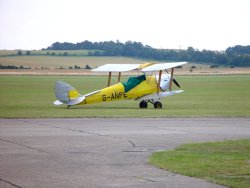 Where are some of these museums? For WW1 buffs, the Old Rheinbeck Aerodrome in New York or the Shuttleworth Collection in the UK are excellent starts. For WW2 buffs, the Commemorative Air Force Museum in Midland, TX (previously known as the Confederate Air Force prior to ‘political correctness’) or the Planes of Fame Museum in Chino, CA. But there is one museum that dwarfs all of these – the Imperial War Museum at the site of the former RAF Duxford airfield. Where are some of these museums? For WW1 buffs, the Old Rheinbeck Aerodrome in New York or the Shuttleworth Collection in the UK are excellent starts. For WW2 buffs, the Commemorative Air Force Museum in Midland, TX (previously known as the Confederate Air Force prior to ‘political correctness’) or the Planes of Fame Museum in Chino, CA. But there is one museum that dwarfs all of these – the Imperial War Museum at the site of the former RAF Duxford airfield.
I recently had an opportunity to spend a day at Duxford, located just east of Cambridge and only a short drive north of London on the M11. I had heard many descriptions about this facility, yet none of these enthusiastic recommendations could prepare me for an outstanding day of sights, sounds and the smell of aircraft petrol and lubricants. What is different about Duxford? Imagine the Smithsonian Institute merging with the Confederate Air Force and taking over an entire airbase formerly operated by the US military. Imagine that this airbase resumes flight operations with the growing collection of airworthy warbirds and this collection is flown to airshows around the country to help the population remember the cost of keeping our country free from foreign invasion. Such is the case with the former RAF Duxford. 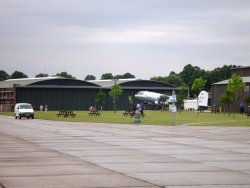 First opened in 1917 to support the Royal Flying Corps, Duxford would later become a major player in the Battle of Britain, serving as the operating base for Douglas Bader and his Hawker Hurricane equipped 242 Squadron. In 1943, the USAAF’s 78th Fighter Group moved into Duxford with its P-47 Thunderbolts. After the war, Duxford continued to serve the RAF as a home for units operating the Gloster Meteor and Gloster Javelin before ceasing flight operations in 1961. With the support of several key organizations, the Imperial War Museum successfully acquired Duxford from the Ministry of Defence in 1977 and it has grown into a unique bastion of aviation history. First opened in 1917 to support the Royal Flying Corps, Duxford would later become a major player in the Battle of Britain, serving as the operating base for Douglas Bader and his Hawker Hurricane equipped 242 Squadron. In 1943, the USAAF’s 78th Fighter Group moved into Duxford with its P-47 Thunderbolts. After the war, Duxford continued to serve the RAF as a home for units operating the Gloster Meteor and Gloster Javelin before ceasing flight operations in 1961. With the support of several key organizations, the Imperial War Museum successfully acquired Duxford from the Ministry of Defence in 1977 and it has grown into a unique bastion of aviation history.
Today, much of Duxford appears the way it did during the Second World War. Visitors enter the Museum Complex through Hangar 1, which is a well-lit modern facility housing many unique aircraft including the UK’s Concorde prototype, one of the TSR.2 prototypes, an Avro Lancaster, de Havilland Mosquito, Panavia Tornado, Hawker Siddeley Buccaneer, Junkers Ju 52, Fieseler Fi 156 Storch, and many more.  Upon exiting Hangar 1, visitors are suddenly aware of the enormity of the ‘museum’. To the left are the grass and concrete runways, still controlled from the WW2-era control tower located at mid-field. On the flight line are an array of available aircraft to take adventurous visitors aloft to view the museum and surrounding area from the air. During my visit, two de Havilland Tiger Moths and a Dragon Rapide were performing this function. Upon exiting Hangar 1, visitors are suddenly aware of the enormity of the ‘museum’. To the left are the grass and concrete runways, still controlled from the WW2-era control tower located at mid-field. On the flight line are an array of available aircraft to take adventurous visitors aloft to view the museum and surrounding area from the air. During my visit, two de Havilland Tiger Moths and a Dragon Rapide were performing this function.
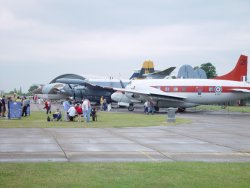 Behind the flightline is an array of transport and military airlift aircraft on static display, many of which are open for visitors to view from the inside. Behind these aircraft lie Hangars 2 through 5. Within these hangars is an intriguing array of airworthy and static display aircraft. Inside one of the hangars were a series of full-scale dioramas from WW2, including a soldier guarding the wreckage of a Bf 109E that crash-landed during the Battle of Britain and another of a pilot emerging from the cockpit of his Hawker Hurricane. In another hangar is another diorama of a soldier guarding the remains of an Argentine Pucara. Behind the flightline is an array of transport and military airlift aircraft on static display, many of which are open for visitors to view from the inside. Behind these aircraft lie Hangars 2 through 5. Within these hangars is an intriguing array of airworthy and static display aircraft. Inside one of the hangars were a series of full-scale dioramas from WW2, including a soldier guarding the wreckage of a Bf 109E that crash-landed during the Battle of Britain and another of a pilot emerging from the cockpit of his Hawker Hurricane. In another hangar is another diorama of a soldier guarding the remains of an Argentine Pucara.
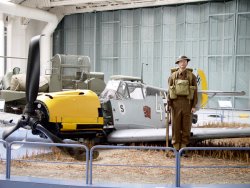 
 
In and amongst these displays is one of the most impressive collections of aircraft. These include: - Avro Lancaster
- British Aerospace Harrier GR.3
- British Aerospace Lightning
- Bristol Beaufighter
- Bristol Blenheim
- Curtiss P-40 Warhawk
- Dassault Mystere IV
- de Havilland Mosquito
- de Havilland Sea Venom
- de Havilland Sea Vixen
- de Havilland Tiger Moth
- de Havilland Vampire
- Douglas A-1 Skyraider
- Fieseler Storch
- Gloster Javelin
- Gloster Meteor
- Grumman F6F Hellcat
- Grumman F7F-2N Tigercat
- Grumman F8F Bearcat
- Hawker Hunter
- Hawker Hurricane
- Hawker Sea Fury
- Hawker Typhoon
- Hawker Sidelley Buccaneer
- Heinkel He 111
- Junkers Ju 52
- Mikoyan MiG-15
- Mikoyan MiG-17
- Mikoyan MiG-21
- Mil Mi-24 Hind
- North American P-51 Mustang
- North American F-86 Sabre
- Republic P-47 Thunderbolt
- Saab Draaken
- Short Sunderland
- Supermarine Spitfire (just about every mark is represented)
- Vought F4U/FG-1 Corsair
- Westland Lysander
- Yakovlev Yak-3
 This is only a fraction of what is spread around these hangars. On the day of my visit, the Royal International Air Tatoo at RAF Fairford was underway, so some of the Duxford collection was on display at Fairford. In addition to the Imperial War Museum’s collection, Duxford is also the operating base for the Breitling Fighter Collection and several other private warbird operators. When not performing on the European Airshow circuit, these beautifully restored aircraft are also on display in these hangars. This is only a fraction of what is spread around these hangars. On the day of my visit, the Royal International Air Tatoo at RAF Fairford was underway, so some of the Duxford collection was on display at Fairford. In addition to the Imperial War Museum’s collection, Duxford is also the operating base for the Breitling Fighter Collection and several other private warbird operators. When not performing on the European Airshow circuit, these beautifully restored aircraft are also on display in these hangars.
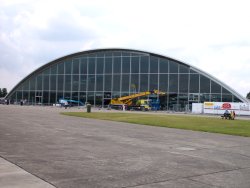 Beyond Hangar 5 is the beautiful facility built to house the American Air Museum. During my visit, the facility was partially closed whilst they finished rearranging the collection to accommodate the B-24 and SR-71 that had moved inside. This collection includes: Beyond Hangar 5 is the beautiful facility built to house the American Air Museum. During my visit, the facility was partially closed whilst they finished rearranging the collection to accommodate the B-24 and SR-71 that had moved inside. This collection includes:
- Boeing B-17G Flying Fortress
- Boeing B-29A Superfortress
- Boeing B-52D Stratofortress
- Consolidated B-24J Liberator
- Douglas C-47 Dakota
- Fairchild A-10A Thunderbolt II
- General Dynamics F-111
- Grumman TBF Avenger
- Lockheed SR-71A Blackbird
- Lockheed T-33A Shooting Star
- Lockheed U-2C
- McDonnell Douglas F-4J Phantom II
- McDonnell Douglas F-15A Eagle (outside)
- North American P-51D Mustang
- North American PBJ Mitchell
- North American F-100D Super Sabre
- Republic P-47 Thunderbolt
I know I missed a number of aircraft in the above lists, but this gives you an idea of the breadth of their collection. If you are a Spitfire buff, Duxford is the place for you as virtually every Mark of Spitfire is represented here (or will be). The museum’s Blenheim is the only airworthy example in the world. 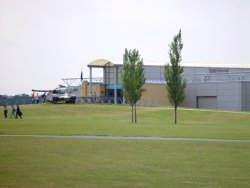 Beyond the aircraft hangars and beyond even the American Air Museum lies yet another facility – the Land Warfare Museum. This facility houses an impressive array of armored vehicles and artillery pieces either operated by the Royal Army or captured by same. Inside the building are a variety of exhibits and full-scale dioramas ranging from World War 1 and World War 2 to some of the more recent operations. Around the outside of this building are more trophies from the Gulf War and vehicles donated for exhibit, including a Scud launcher from the Czech Republic. Beyond the aircraft hangars and beyond even the American Air Museum lies yet another facility – the Land Warfare Museum. This facility houses an impressive array of armored vehicles and artillery pieces either operated by the Royal Army or captured by same. Inside the building are a variety of exhibits and full-scale dioramas ranging from World War 1 and World War 2 to some of the more recent operations. Around the outside of this building are more trophies from the Gulf War and vehicles donated for exhibit, including a Scud launcher from the Czech Republic.
 Behind the hangars is yet another interesting display that can easily be overlooked. It is the operations center that has been restored to its original configuration for the air defense of Britain during WW2, complete with plotting table, overlooking communications and command desks, and wall-mounted squadron status displays. Behind the hangars is yet another interesting display that can easily be overlooked. It is the operations center that has been restored to its original configuration for the air defense of Britain during WW2, complete with plotting table, overlooking communications and command desks, and wall-mounted squadron status displays.
You should plan on spending at least one full day at Duxford to take in all of the exhibits. It is very important that you dress comfortably (especially your walking shoes) and there are several cafeterias located around the facility to rest and replenish. For those of you unable to walk the distance between all of the Duxford facilities, there is a tram that runs all day to carry you between all of the hangars and exhibit halls. No good museum is complete without a well-stocked gift shop that has a dangerous array of aviation history publications, die-cast aircraft and (of course) plastic model kits. If you have the opportunity to visit the UK in the future, I would highly recommend putting Imperial War Museum at Duxford at the top of your sightseeing list! Of all of the air museums that I have had the pleasure to visit in my travels, Duxford now resides at the top of my list.   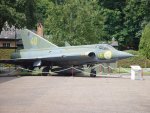 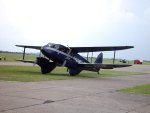
  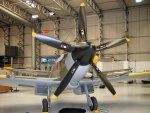 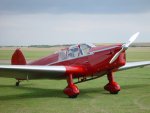
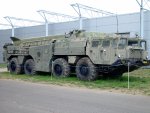 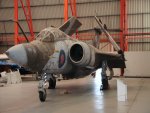 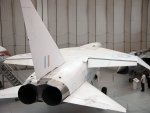 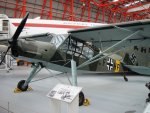
Click on a photo to see a larger version then use the 'Back' button on your browser to return to this page.
| 








|

 Where are some of these museums? For WW1 buffs, the Old Rheinbeck Aerodrome in New York or the Shuttleworth Collection in the UK are excellent starts. For WW2 buffs, the Commemorative Air Force Museum in Midland, TX (previously known as the Confederate Air Force prior to ‘political correctness’) or the Planes of Fame Museum in Chino, CA. But there is one museum that dwarfs all of these – the Imperial War Museum at the site of the former RAF Duxford airfield.
Where are some of these museums? For WW1 buffs, the Old Rheinbeck Aerodrome in New York or the Shuttleworth Collection in the UK are excellent starts. For WW2 buffs, the Commemorative Air Force Museum in Midland, TX (previously known as the Confederate Air Force prior to ‘political correctness’) or the Planes of Fame Museum in Chino, CA. But there is one museum that dwarfs all of these – the Imperial War Museum at the site of the former RAF Duxford airfield. First opened in 1917 to support the Royal Flying Corps, Duxford would later become a major player in the Battle of Britain, serving as the operating base for Douglas Bader and his Hawker Hurricane equipped 242 Squadron. In 1943, the USAAF’s 78th Fighter Group moved into Duxford with its P-47 Thunderbolts. After the war, Duxford continued to serve the RAF as a home for units operating the Gloster Meteor and Gloster Javelin before ceasing flight operations in 1961. With the support of several key organizations, the Imperial War Museum successfully acquired Duxford from the Ministry of Defence in 1977 and it has grown into a unique bastion of aviation history.
First opened in 1917 to support the Royal Flying Corps, Duxford would later become a major player in the Battle of Britain, serving as the operating base for Douglas Bader and his Hawker Hurricane equipped 242 Squadron. In 1943, the USAAF’s 78th Fighter Group moved into Duxford with its P-47 Thunderbolts. After the war, Duxford continued to serve the RAF as a home for units operating the Gloster Meteor and Gloster Javelin before ceasing flight operations in 1961. With the support of several key organizations, the Imperial War Museum successfully acquired Duxford from the Ministry of Defence in 1977 and it has grown into a unique bastion of aviation history. Upon exiting Hangar 1, visitors are suddenly aware of the enormity of the ‘museum’. To the left are the grass and concrete runways, still controlled from the WW2-era control tower located at mid-field. On the flight line are an array of available aircraft to take adventurous visitors aloft to view the museum and surrounding area from the air. During my visit, two de Havilland Tiger Moths and a Dragon Rapide were performing this function.
Upon exiting Hangar 1, visitors are suddenly aware of the enormity of the ‘museum’. To the left are the grass and concrete runways, still controlled from the WW2-era control tower located at mid-field. On the flight line are an array of available aircraft to take adventurous visitors aloft to view the museum and surrounding area from the air. During my visit, two de Havilland Tiger Moths and a Dragon Rapide were performing this function. Behind the flightline is an array of transport and military airlift aircraft on static display, many of which are open for visitors to view from the inside. Behind these aircraft lie Hangars 2 through 5. Within these hangars is an intriguing array of airworthy and static display aircraft. Inside one of the hangars were a series of full-scale dioramas from WW2, including a soldier guarding the wreckage of a Bf 109E that crash-landed during the Battle of Britain and another of a pilot emerging from the cockpit of his Hawker Hurricane. In another hangar is another diorama of a soldier guarding the remains of an Argentine Pucara.
Behind the flightline is an array of transport and military airlift aircraft on static display, many of which are open for visitors to view from the inside. Behind these aircraft lie Hangars 2 through 5. Within these hangars is an intriguing array of airworthy and static display aircraft. Inside one of the hangars were a series of full-scale dioramas from WW2, including a soldier guarding the wreckage of a Bf 109E that crash-landed during the Battle of Britain and another of a pilot emerging from the cockpit of his Hawker Hurricane. In another hangar is another diorama of a soldier guarding the remains of an Argentine Pucara. This is only a fraction of what is spread around these hangars. On the day of my visit, the Royal International Air Tatoo at RAF Fairford was underway, so some of the Duxford collection was on display at Fairford. In addition to the Imperial War Museum’s collection, Duxford is also the operating base for the Breitling Fighter Collection and several other private warbird operators. When not performing on the European Airshow circuit, these beautifully restored aircraft are also on display in these hangars.
This is only a fraction of what is spread around these hangars. On the day of my visit, the Royal International Air Tatoo at RAF Fairford was underway, so some of the Duxford collection was on display at Fairford. In addition to the Imperial War Museum’s collection, Duxford is also the operating base for the Breitling Fighter Collection and several other private warbird operators. When not performing on the European Airshow circuit, these beautifully restored aircraft are also on display in these hangars. Beyond Hangar 5 is the beautiful facility built to house the American Air Museum. During my visit, the facility was partially closed whilst they finished rearranging the collection to accommodate the B-24 and SR-71 that had moved inside. This collection includes:
Beyond Hangar 5 is the beautiful facility built to house the American Air Museum. During my visit, the facility was partially closed whilst they finished rearranging the collection to accommodate the B-24 and SR-71 that had moved inside. This collection includes: Beyond the aircraft hangars and beyond even the American Air Museum lies yet another facility – the Land Warfare Museum. This facility houses an impressive array of armored vehicles and artillery pieces either operated by the Royal Army or captured by same. Inside the building are a variety of exhibits and full-scale dioramas ranging from World War 1 and World War 2 to some of the more recent operations. Around the outside of this building are more trophies from the Gulf War and vehicles donated for exhibit, including a Scud launcher from the Czech Republic.
Beyond the aircraft hangars and beyond even the American Air Museum lies yet another facility – the Land Warfare Museum. This facility houses an impressive array of armored vehicles and artillery pieces either operated by the Royal Army or captured by same. Inside the building are a variety of exhibits and full-scale dioramas ranging from World War 1 and World War 2 to some of the more recent operations. Around the outside of this building are more trophies from the Gulf War and vehicles donated for exhibit, including a Scud launcher from the Czech Republic. Behind the hangars is yet another interesting display that can easily be overlooked. It is the operations center that has been restored to its original configuration for the air defense of Britain during WW2, complete with plotting table, overlooking communications and command desks, and wall-mounted squadron status displays.
Behind the hangars is yet another interesting display that can easily be overlooked. It is the operations center that has been restored to its original configuration for the air defense of Britain during WW2, complete with plotting table, overlooking communications and command desks, and wall-mounted squadron status displays.






















